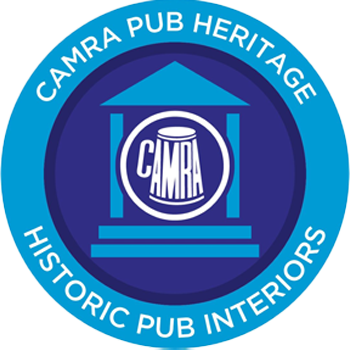This website is currently in beta. If you wish to go back to the current site please click here. To provide feedback or find out more about this site, please click here.


28/09/23 - 2 cask beers on, Morland Old Golden Hen and a GK seasonal - nice to see. In a subsequent visit on 13/10/23 we were informed that GK IPA would no longer be on tap - instead it would be a Morland branded beer + a seasonal. Ine June 2024 we found Abbot and Deuchars IPA - clearly things change.
The Northern Lane station is closed until Easter next year. - overland still ok Tufnell Park is probably the best alternative. Or walk from Kentish Town West or Gospel Oak.
Built in 1896 and designed by Thorpe and Furniss of nearby Camden, the building is a striking landmark in Kentish Town (Grade II listed) with a large and prominent French chateau style tower adding to its status. Inside, the bar cabinet work, etched glass and bar-back, wall mirrors and ceiling are all of exceptional character and design. There is a fine skylight in the former billiard room at the back. The interior is exceptionally large, naturally lit by huge clear picture windows, opened out in recent years and is served by a very large single bar which extends from the front room, round the side and into the back room. A CAMRA Heritage Pub. The toilets, accessible from the back room, are downstairs, with a disabled facility on the ground floor.
On a visit in Jan 2021 only GK IPA avaialble.
Historic Interest
Grade II listing:- Public house. 1898. By Thorpe and Furniss; wrought-iron work by Jones & Willis; glass by W James of Kentish Town; interior plasterwork by the Plastic Decoration Company; joinery by WA Antill & Co. Red brick and stucco. Slate roofs with dormers. STYLE: French Chateau style. PLAN: situated on a canted corner site with projecting ground floor frontage. EXTERIOR: 3 storeys, attics and cellars. Ground floor with pink and black polished granite pilasters supporting fascia and cornice with elaborate wrought-iron balustrade and segmental-arched stuccoed gables over entrances, that facing into Leighton Road with an aedicule containing a figure. 5 entrances (1 now blocked) with half glazed panelled doors and overlights. Entrances to extreme left and right with lobbies having French embossed and brilliant cut mirrors to walls, elaborate wrought-iron screen incorporating the letters "AH" and mosaic floors. Main frontage windows with top strip of small panes and all frontage windows with mostly original French embossed and brilliant cut glass in lower panes. 1st floor with 5-light bow window to Kentish Town Road, a canted 5-light bay, 2-light window, 4-light bay and single light, all with transoms and mullions and pilaster architraves supporting an entablature with enriched frieze. 2nd floor similar but with entablature having modillion cornice with enriched blocking course breaking forward over bays. Extreme right hand bay replaced by enriched console. At eaves level the bowed window culminates in a 5-light turret with enriched friezes and conical roof with finial. On the corner, 4 dormers with pilaster architraves supporting pediments terminating in shell finials; into Leighton Road, above the 4-light canted bay, an attic storey with two 2-light windows and pilasters supporting similar entablature to that below. High, steep hipped roof over this bay with cast-iron cresting, pedimented dormer and large slab chimney to side. INTERIOR: of high standard retains original mahogany fittings, French embossed and brilliant cut glass and mirrors. Elaborately moulded plaster ceiling in Jacobean style. Lantern with raised clerestory in rear bar with stained glass detailing. Front bar altered.
One star - A pub interior of special national historic interest
Listed status: II
Designed by architects Thorpe & Furniss and opened in 1898. The interior has undergone a pretty comprehensive modernisation yet there is still a lot of historic work to enjoy. The best feature is one of the most elaborate panel-and-mirror displays anywhere. Set in tall rectangular panels are etched and cut mirrors with birds, foliage, swags and other decorative devices (note that a couple of large panels are later replacements – they lack the brilliant cutting of the Victorian originals). The surviving bar-back in the rear room, a tall, delicate piece, has similar work and is further embellished with touches of gilding. Note also the cast-iron columns and the back room which has a large skylight to what was originally a billiard room.
When it opened in 1898 this pub epitomised the grand, luxurious kind of establishment that was the hallmark of the great pub boom. The architects were Thorpe & Furniss. They provided an ambitious design outside in the Flemish Renaissance style which boasts a tourelle on the corner. There is ornate ironwork, polished stone facing on the ground floor and a series of prominent dormer windows. The interior has undergone a pretty comprehensive modernisation yet there is still a lot of historic work to enjoy. You can still appreciate that the multiple entrances would have given access to a compartmentalised interior of the kind the Victorians liked. Even today, the front part (completely gutted) feels physically separated from the back.
The best feature is the survival in the rear parts of one of the most elaborate panel-and-mirror displays anywhere. Set in tall rectangular panels are etched and cut mirrors with birds, foliage, swags and other decorative devices (note that a couple of large panels are later replacements â they lack the brilliant cutting of the Victorian originals). The surviving bar-back, a tall, delicate piece, has similar work and is further embellished with touches of gilding. Other things to note are the lavish ceiling, cast-iron columns and the back room which has a large skylight to what was originally a billiard room.
This Pub serves 2 changing beers and 0 regular beers.
Assembly House, London
Changing beers typically include: Greene King (seasonal) , Morland (varies)
Source: National